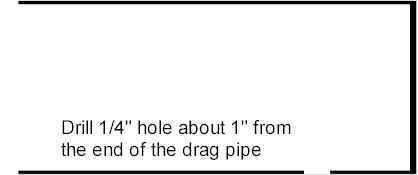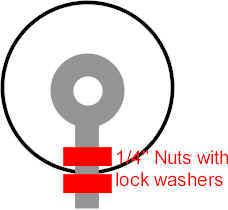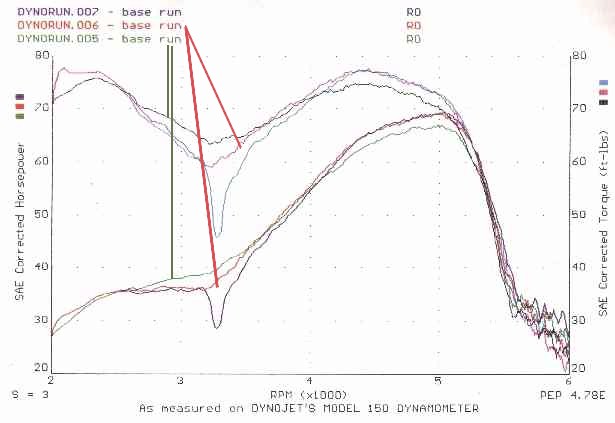Making Drag Pipes Work
If you insist on using drag pipes on your bike, there is something you can do
to improve the low and mid range power produced by the engine. Even with the
improvement listed here, the streetable engine power is not going to match power
output of a good 2-1 or 2-2 exhaust system. Motorcycle Performance Guide does
not recommend drag pipes or porker 2" pipes for serious street engines, but
the performance fix listed here will improve the power of your drag pipes.
Results have been confirmed by dyno results.
If it is loud, it must be fast?
If you are serious about
making horsepower on the street with your Harley-Davidson, drag pipes will not fit into your
engine program plans. Serious street power requires a serious exhaust system.
Exhaust systems like the SuperTrapp 2-1, Hooker, White Bros. E-series
2-1, Vance&Hines, Khrome Werks and Cycle Shack
2-2 Slash Cut exhaust have a long track record of "making
power". The familiar sound of a drag pipe may be music to a
"bikers" ears, but the performance rider hears the labored
acceleration as the motorcycle moves by.
Drag pipes do have their place. It is on
the drag strip where the engine runs in a very narrow RPM band. On the
street, stick with proven winners.
Dyno testing of exhaust systems for EVO
and Twin Cam engines is now available.
EVO Exhaust
Twin Cam Exhaust
|
The first item to get modified or changed on most new Harley-Davidson motorcycles is
the exhaust system. Getting the proper Harley sound always seems to require increasing the
decibel level out the exhaust, with many riders installing drag pipes as the exhaust
system for the proper sound. The rider often believes that by reducing back pressure in
the exhaust system the engine will also increased power. This is wrong. As a resulting of
changing a stock exhaust system to Drag Pipes, most engines promptly lose 5-10%
of the power the engine produced.
By properly re-jetting the carburetor and adding a free flowing air cleaner to
an engine with drag pipes, the maximum horsepower produced will improve over the stock engine. But
there is
a difference between usable power and maximum horsepower. The maximum horsepower of two engines
may be similar, but the horsepower torque curves may be different. The area under the
horsepower and torque curves defines the "power" the engine produces. The more
area that is under the curve, the better the power.
A typical drag pipe produces a horsepower curve that initially rises very slow. As the
RPMs start to rise above mid-range power, the curve begins to rise at increasing rate
until maximum horsepower is achieved. Once RPMs have passed maximum horsepower, the curve
drops of rapidly.
The horsepower curve of a typical 2-2 pipe like the Cycle Shack Slash Cuts produces a
curve that may actually be closer to a straight line from low RPMs up through the rpm that
maximum horsepower is produced. Once maximum horsepower is achieved, the curve drops at a
relatively mild rate.
The horsepower curve of a typical 2-1 pipe like the SuperTrapp starts off slightly
lower than the 2-2 pipe, but rises at a rapid rate in the mid rpm ranges. As the rpm range
approaches maximum horsepower, the curve flattens out. Once maximum horsepower is
achieved, the curve drops of rapidly.
Ok. It is loud and it isn't fast!
If your taste in bike styling requires that drag pipe must be used, there is some hope
to getting back some of that lost low to mid rpm power. Here is a poor boys trick that
will make your drag pipes work much more effectively. This setup can actually be tuned to
meet the performance needs of the bike.
 |
Make a tunable baffle by
purchasing a 1/4"x1" thumb screw or taking a 3/4"
outside diameter washer and weld it to the top of a 3/4" x 1/4"
bolt. Now Drill
a 1/4" hole about 1" from the end of the drag pipes. Take the tunable baffle
and place a 1/4" nut and a lock washer (away from the large washer) the on it. Now
insert your tunable baffle into the exhaust pipe like the example below. |
|
Visitors to the Bike Tech
WEB site constantly provide improvements to this idea. If you don't have access to welding
equipment, try this handy little trick sent to me by Nick
What I used was 1/4" x 1"
thumb screws which can readily purchased at any local hardware store for about $ 0.50 a
piece. They work great. The "football" shaped head on the screws measure
approximately 3/4" x 1/2" so they have about the same surface area as the
3/4" o.d. washer because of the lack of the hole. And they do not require any
fabrication.
It is amazing what a little creative thinking can come up
with. |
 |
 You can tune the baffle
by changing the angle of the thumbscrew or washer to the exhaust pipe. For maximum torque, the washer
will be at 90 degree angle to the pipe. For maximum horsepower the washer will be parallel
to the pipe. You can tune the baffle
by changing the angle of the thumbscrew or washer to the exhaust pipe. For maximum torque, the washer
will be at 90 degree angle to the pipe. For maximum horsepower the washer will be parallel
to the pipe.
|
How well does this work?
Bike Tech received a dyno run sheet from Gene P. that just showed what
happened by changing the angle of the thumbscrew. Three runs were done.
Thumbscrew parallel to the pipe (run 7), 45 degrees to pipe (run 6) and 90
degrees (run 5) to the pipe. Judge the results for yourself. This also shows you
the benefits of dyno tuning something as simple as your exhaust system.
Run 7 (open or parallel to the pipe) Makes the most power, but has a huge
hole in the power band just above 3000 RPMs
While run 5 makes the lowest horsepower (approximately 68), the 2500-4000 RPM
power is the highest. This is the RPM band that most riders spend there time
riding.
Run 6 improves the 3000-4000 RPM horsepower drop over run 7 without any
significant drop in maximum power.
 |
Where did this come from?
This isn't some new technology that was just discovered. Any rider who remembers the
Honda 250 and 305 Scramblers of the 70's should be quite familiar with the technology. In
addition to tuning the power band, it also adjusted the amount of noise that came out the
exhaust pipes. It was a well know trick when it was done by Honda.
For those of you who are willing experiment more, the size of the washer can be
increased as can the size of the hole in the washer. A strong spring can be used to hold
the washer in place in relationship to the pipe and a "wing nut" arrangement can be used to
adjust the angle of the washer.
I want to thank Terry for remembering this trick
and bringing it to my attention. He was looking for some additional power from this bike.
The cost of a new set of pipes was not in his budget at the time so the following
suggestion was made by the Motorcycle Performance Guide staff
"If you want to use the 'poor boy' trick to make your drag pipes work better,
just drill a 1/4" hole about 1" from the end of your drag pipes then put a 1
1/4" by 1/4" bolt through it with the shaft inside the drag pipe. Place a about
1/2" of washers inside the exhaust on the bolt then add a lock washer and nut.
Tighten it down and take if for a ride. This should improve the mid range power, and it
might have cost you $2.00 . You can actually tune the power range a little by adding or
removing washers, or altering the length of the bold. Cheap Trick!!"
|
Terry responded back with the following
message:
"I tried that and it made some difference but not tremendous. I then took a
1/4" x1" bolt and welded a 3/4" diameter washer to the head of the bolt so
it looked like a candy sucker. I used a nut on inside of pipe and a nut on outside of pipe
with "sucker " inside the pipe. By turning the "sucker", could vary
amount of resistance to exhaust flow. I ended up with washer flat across pipe for maximum
resistance. That made a TREMENDOUS difference in mid range power and quieted it very
slightly. Unbelievable difference! Don't have a dyno to provide numbers, but I KNOW it's
much quicker."
We appreciates Terry's efforts. It's the little tricks like this that help all riders.
If you have a tip that solves a performance or maintenance situation, E-mail us with your
suggestion. |
| |
|